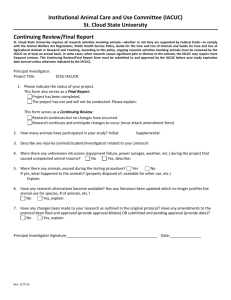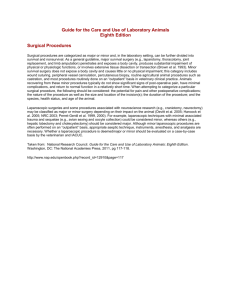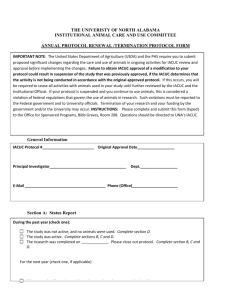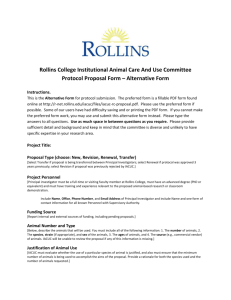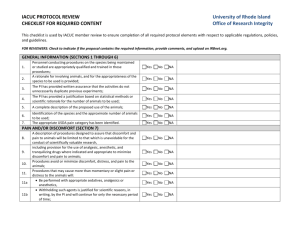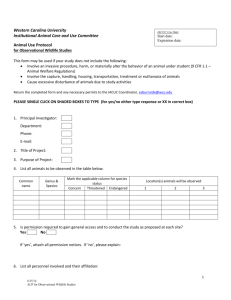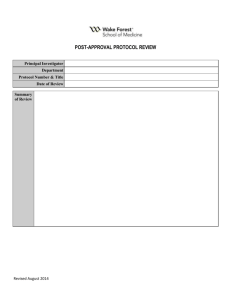Animal Care and Use Program Policies & Procedures Multiple
advertisement
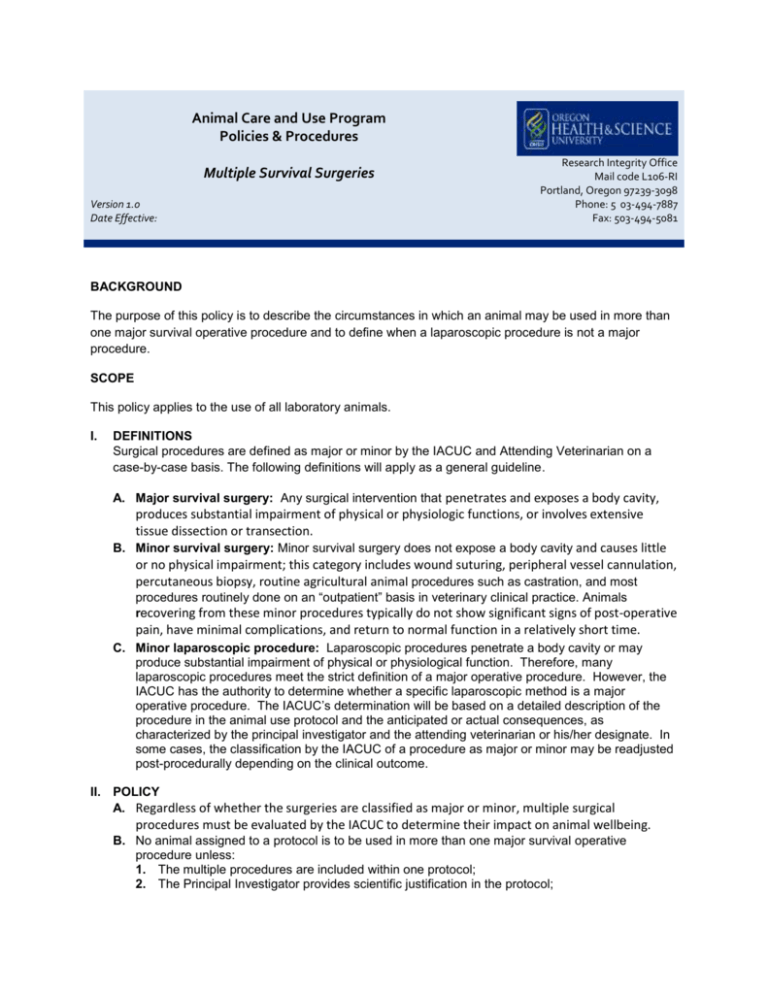
Animal Care and Use Program Policies & Procedures Multiple Survival Surgeries Version 1.0 Date Effective: Research Integrity Office Mail code L106-RI Portland, Oregon 97239-3098 Phone: 5 03-494-7887 Fax: 503-494-5081 BACKGROUND The purpose of this policy is to describe the circumstances in which an animal may be used in more than one major survival operative procedure and to define when a laparoscopic procedure is not a major procedure. SCOPE This policy applies to the use of all laboratory animals. I. DEFINITIONS Surgical procedures are defined as major or minor by the IACUC and Attending Veterinarian on a case-by-case basis. The following definitions will apply as a general guideline. A. Major survival surgery: Any surgical intervention that penetrates and exposes a body cavity, produces substantial impairment of physical or physiologic functions, or involves extensive tissue dissection or transection. B. Minor survival surgery: Minor survival surgery does not expose a body cavity and causes little or no physical impairment; this category includes wound suturing, peripheral vessel cannulation, percutaneous biopsy, routine agricultural animal procedures such as castration, and most procedures routinely done on an “outpatient” basis in veterinary clinical practice. Animals recovering from these minor procedures typically do not show significant signs of post-operative pain, have minimal complications, and return to normal function in a relatively short time. C. Minor laparoscopic procedure: Laparoscopic procedures penetrate a body cavity or may produce substantial impairment of physical or physiological function. Therefore, many laparoscopic procedures meet the strict definition of a major operative procedure. However, the IACUC has the authority to determine whether a specific laparoscopic method is a major operative procedure. The IACUC’s determination will be based on a detailed description of the procedure in the animal use protocol and the anticipated or actual consequences, as characterized by the principal investigator and the attending veterinarian or his/her designate. In some cases, the classification by the IACUC of a procedure as major or minor may be readjusted post-procedurally depending on the clinical outcome. II. POLICY A. Regardless of whether the surgeries are classified as major or minor, multiple surgical procedures must be evaluated by the IACUC to determine their impact on animal wellbeing. B. No animal assigned to a protocol is to be used in more than one major survival operative procedure unless: 1. The multiple procedures are included within one protocol; 2. The Principal Investigator provides scientific justification in the protocol; 3. The Institutional Animal Care and Use Committee (IACUC) provides their approval; and 4. An exemption is obtained from the USDA for animals covered under the Animal Welfare Act Regulations. C. An animal that has an emergency major operative procedure as part of proper veterinary care may still be used in a proposal that requires a major survival operative procedure with the consent of the attending veterinarian or his/her designate. D. A major survival operative procedure may not be performed a second time on an animal in a separate protocol without IACUC approval for non-USDA regulated animals and without IACUC approval and an exemption from the USDA for animals covered under the Animal Welfare Act Regulations. E. Animals surviving a major operative procedure must be identified using written documentation on the cage card and in the medical record to prevent their use in a second major survival operative procedure without the required permissions and exemptions. III. PROCEDURES A. An investigator proposing to use non-USDA regulated animals in more than one major survival operative procedure within one protocol or subsequently in a different protocol must indicate that multiple surgeries will be performed and provide scientific justification to the IACUC in all protocols under which the animal(s) will be covered. B. Investigators proposing to use USDA-regulated animals in more than one major survival operative procedure within one protocol or subsequently in a different protocol are encouraged to contact the IACUC office for assistance with drafting the request to the USDA. The OHSU Institutional Official must make the exemption request to the USDA Animal Care Regional Director who will forward it to the Animal Care Assistant Deputy Administrator for review and recommendation to the USDA Deputy Administrator. The request for exemption should include the following information: 1. An outline of the research protocols for which the procedure is requested; 2. The species and the approximate number of animals involved in the exemption request; 3. The time frame for the proposed exempt procedure; 4. The number of major operative procedures to be performed on a given animal, the frequency of such procedures, and the period of time between each major operative procedure; 5. Measures to be taken to ensure that pain/distress are minimized; 6. A complete justification for the exemption (note that cost is not normally a major criterion); 7. An assurance that all other stipulated requirements of the AWA and regulations will be met in consideration of this exemption; and 8. An assurance that OHSU’s IACUC has approved the exemption. C. The Animal & Plant Health Inspection Service (APHIS) may respond to the formal request by approving the request as written, granting a portion of the request, imposing additional limitations, or denying the request. An annual IACUC evaluation of the exemption is required, which consists of an IACUC assessment of the animals and the effectiveness and soundness of the methods and procedures used. Considerations for the renewal or continuation of the exemption will be based on the IACUC’s recommendations following their review. The exemption must be included in the Annual Report (APHIS Form 7023). IV. MINOR LAPAROSCOPIC PROCEDURES (WEST CAMPUS) The OHSU West Campus IACUC has designated the following laparoscopic procedures as minor surgery when performed on non-human primates at the Oregon National Primate Research Center: Ovarian Evaluation Ovarian ligament evaluation Removal of Intraovarian Catheters Oviductal Embryo Transfer Embryo Transfer, Multiple Salpingoophorectomy, Unilateral or Bilateral Ovarian Epithelial Resection Ovarian Follicle Aspiration, Single or Multiple Oophorectomy, Unilateral or Bilateral Exploratory laparoscopy Laparascopic endometrial seeding Oophorectomy Unilateral + Salpingoophorectomy Unilateral Liver Biopsy Fat & Liver Biopsy + Muscle Biopsy Fimbriaectomy, Unilateral or Bilateral V. AUTHORITY AWA, Section 13(a)(3)(D,E) & 9 CFR Part 2, Section 2.31 (d)(1)(x): “Major Survival Surgery, Single vs. Multiple Procedures.” No animal assigned to a proposal is to be used in more than one major survival operative procedure unless the multiple procedures are included within one proposal, justified for scientific reasons by the Principal Investigator, and preapproved by the Institutional Animal Care and Use Committee (IACUC). However, an animal that has an emergency major operative procedure as part of proper veterinary care may still be used in a proposal that requires a major survival operative procedure. A major survival operative procedure must not be performed a second time on an animal in a separate proposal. In order to comply with the intent of the Animal Welfare Act (AWA), animals surviving a major operative procedure must be identified (written documentation) to prevent their use in a second major survival operative procedure. http://www.aphis.usda.gov/animal_welfare/downloads/policy/policy14.pdf http://edocket.access.gpo.gov/cfr_2008/janqtr/pdf/9cfr2.31.pdf VI. Guidance NIH FAQs Are major multiple survival surgical procedures permitted on a single animal? The Guide discourages multiple major survival surgical procedures on a single animal but provides that if scientifically justified by the user and approved by the IACUC they may be permitted. Guide examples of justifications include (1) procedures that are related components of a research project; (2) conservation of scarce animal resources, and (3) clinical necessity. The Guide does not consider cost savings alone an adequate reason for performing major multiple survival surgical procedures. [A7] Note that under the AWA regulations, major multiple survival surgical procedures are permitted only if the multiple procedures are included within one proposal, justified for scientific reasons, and approved by the IACUC. The AWA requires prior authorization of the USDA Administrator, Animal and Plant Health Inspection Service, for an exemption from this requirement. [See 9 CFR, Part 2, Section 2.31 (d)(1)(x)] Are laparoscopic procedures considered major surgery? The Guide for the Care and Use of Laboratory Animals 2011 states: “Surgical procedures in the laboratory setting may be categorized as major or minor (USDA 1985). Whether a procedure is major or minor should be evaluated on a case-by-case basis, as determined by the veterinarian and IACUC (NRC 2003b; Silverman et al. 2007; for additional discussion see Chapter 4, Surgical Procedures). Regardless of classification, multiple surgical procedures on a single animal should be evaluated to determine their impact on the animal’s wellbeing. Multiple major surgical procedures on a single animal are acceptable only if they are (1) included in and essential components of a single research project or protocol, (2) scientifically justified by the investigator, or (3) necessary for clinical reasons. Conservation of scarce animal resources may justify the conduct of multiple major surgeries on a single animal, but the application of such a practice on a single animal used in separate protocols is discouraged and should be reviewed critically by the IACUC. When applicable, the IO must submit a request to the USDA/APHIS and receive approval in order to allow a regulated animal to undergo multiple major survival surgical procedures in separate unrelated research protocols (USDA 1985, 1997a). Justifications for allowing animals not regulated by the USDA to undergo multiple survival procedures that meet the above criteria should conform to those required for regulated species. If multiple survival surgery is approved, the IACUC should pay particular attention to animal well-being through continuing evaluation of outcomes. Cost savings alone is not an adequate reason for performing multiple major survival surgical procedures. Some procedures characterized as minor may induce substantial post-procedural pain or impairment and should similarly be scientifically justified if performed more than once in a single animal. "
